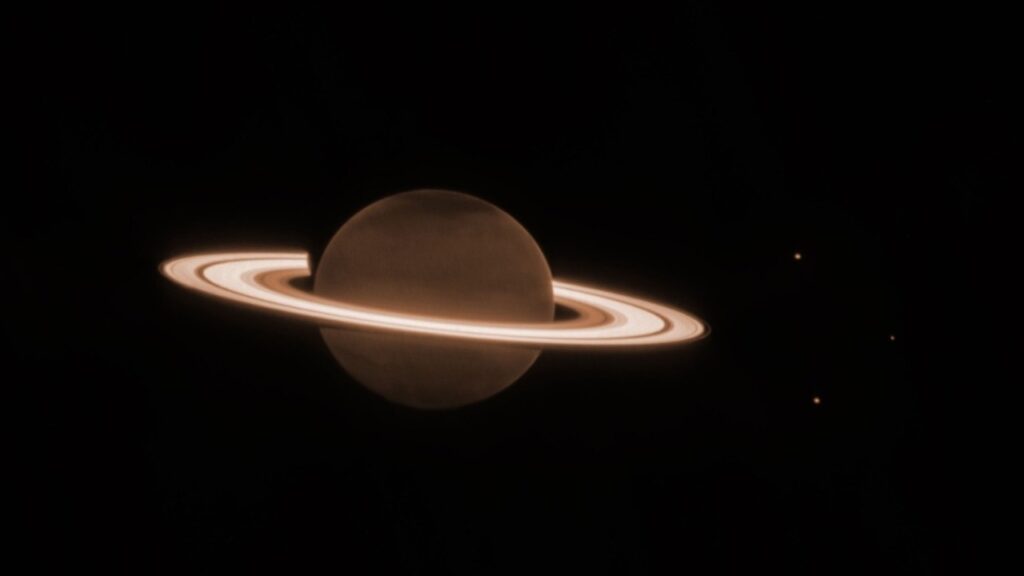The James Webb Space Telescope (JWST) is about to embark on a dazzling cosmic light show – investigating the auroras of Uranus and Saturn, the solar system’s majestic gas and ice giants.
These otherworldly light displays, similar to Earth’s Northern and Southern Lights, hold the key to unlocking the mysteries of these distant giants and the energetic processes that govern their atmospheres.
Unveiling the Enigmatic Auroras of Uranus
One team, led by Dr. Henrik Melin from the University of Leicester, will focus on Uranus, the distant ice giant tilted on its side like a spinning top. This unique tilt positions its auroras around the equator instead of the poles, unlike Earth’s. Unlike the well-studied auroras of Jupiter and Saturn, relatively little is known about Uranus’s auroras. They were only confirmed in 2022 using infrared observations, leaving many questions unanswered.
JWST’s NIRCam instrument, boasting exceptional sensitivity in the near-infrared spectrum, will be instrumental in unraveling the secrets of Uranus’s auroras. Here are some of the key objectives of this investigation:
- Mapping a dynamic dance of light: By capturing images of Uranus over a single Uranian day (roughly 17 Earth hours), scientists aim to create a detailed map of auroral activity across the entire rotation of its magnetic field. This will provide the first-ever comprehensive view of how these auroras ebb and flow over time.
- Unraveling the source of energy: A key question is whether these auroras, like Earth’s, are primarily triggered by charged particles from the Sun’s solar wind, or if internal sources within the Uranian system play a more prominent role, similar to Jupiter’s auroras. The possibility also exists that both mechanisms contribute, as with Saturn.
- A connection to unexpected warmth: One intriguing theory suggests that Uranus’ auroras might be responsible for the planet’s surprisingly high temperatures. JWST’s observations may provide crucial evidence to support or refute this hypothesis. By studying the distribution and intensity of the auroral activity, scientists hope to determine if this energetic phenomenon could be transferring heat from the aurora down towards the equator, influencing Uranus’s overall energy balance.
These observations, commencing in early 2025, promise to revolutionize our understanding of Uranus’ auroras and their potential impact on the planet’s overall energy balance. They may even shed light on the formation and evolution of Uranus’s unique atmospheric features.
Decoding the Dynamics of Saturn’s Auroras
Another JWST project, led by Dr. Luke Moore from Boston University, will set its sights on Saturn, the ringed giant renowned for its spectacular auroras. While Saturn’s auroras have been observed previously by telescopes like Hubble, JWST’s capabilities will allow for a much deeper and more nuanced understanding of these dynamic phenomena.
Their investigation using NIRCam will focus on:
- Monitoring temperature variations: By observing Saturn’s northern auroral region for an entire Saturnian day (roughly 10.6 hours), the team aims to track how the temperature of this region changes as the planet rotates. This data will provide valuable insights into the energy dynamics driving these auroras. Traditionally, auroras have been associated with the influx of charged particles. By studying how the auroral temperatures fluctuate, scientists can learn more about how efficiently these particles deposit their energy into the atmosphere.
- Identifying the source of charged particles: Understanding the origin of the charged particles powering Saturn’s auroras – whether primarily from the Sun’s solar wind or internal sources within the Saturnian system, such as its interaction with its moon Enceladus – is another key objective. This will help scientists develop a more complete picture of the physical processes governing Saturn’s auroral activity.
These observations will provide the first-ever detailed look at Saturn’s auroral energies in the near-infrared spectrum, shedding light on the complex processes fueling these mesmerizing displays. They may also reveal connections between Saturn’s auroras, its magnetosphere, and the ongoing exchange of material with its rings and moons.
Beyond Our Solar System: Implications for Exoplanets
The knowledge gleaned from studying these alien auroras will extend far beyond our solar system. As Dr. Emma Thomas, a researcher involved in the Uranus project, points out:

“A majority of exoplanets discovered so far are similar in size to Neptune and Uranus, suggesting they might also share comparable magnetic and atmospheric characteristics. By analyzing the connection between Uranus’s auroras and its magnetic field and atmosphere, we can potentially make predictions about the atmospheres and magnetic fields of these distant worlds, ultimately aiding in the search for potentially habitable exoplanets.”
The JWST’s investigation of auroras on Uranus and Saturn promises to be a groundbreaking chapter in our understanding of these celestial light shows and their role in shaping planetary



















